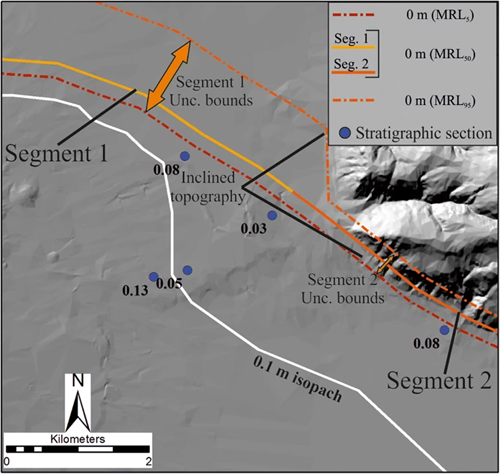Estimating eruptive parameters and related uncertainties for pyroclastic density currents deposits: worked examples from Somma-Vesuvius (Italy)

Cioni R., A. Tadini, L. Gurioli, A. Bertagnini, M. Mulas, A. Bevilacqua & A. Neri (2020).
Bulletin of Volcanology, 82/65, https://doi.org/10.1007/s00445-020-01402-7.
Abstract
The quantification of the maximum runout, invaded area, volume, and total grain-size distribution (TGSD) of pyroclastic density currents (PDC) is a critically important task because such parameters represent the needed necessary input quantities for physical modeling and hazard assessment of PDCs. In this work, new and well-established methods for the quantification of these parameters are applied to a large stratigraphic dataset of three PDC units from two eruptions of Somma-Vesuvius (the AD 79 Pompeii and the AD 472 Pollena eruptions), representative of a large spectrum of transport and depositional processes. Maximum runout and invaded area are defined on the basis of the available volcanological and topographical constraints. The related uncertainties are evaluated with an expert judgment procedure, which considersed the different sectors of the volcano separately. Quite large uncertainty estimates of dispersal area (20–40%) may have important implications in terms of hazard assessment. The testing of different methods for estimating the volume (and mass) of a PDC deposit suggests that integration, over the invaded area, of thickness (and deposit density) data using the triangulated irregular network method can minimize and localize data extrapolation. Such calculations, however, bear an intrinsic additional uncertainty (at least 10% of the total PDC deposit) related to loss or new formation of fine material during transport (at least 10% of the total PDC deposit). Different interpolation methods for TGSD produce multimodal distributions, likely reflecting the different response of each grain size class to transport and deposition processes. These data, when integrated with information on the related co-ignimbrite deposits, can give a more accurate picture of the pyroclastic mixture feeding the current.


Devi effettuare l'accesso per postare un commento.